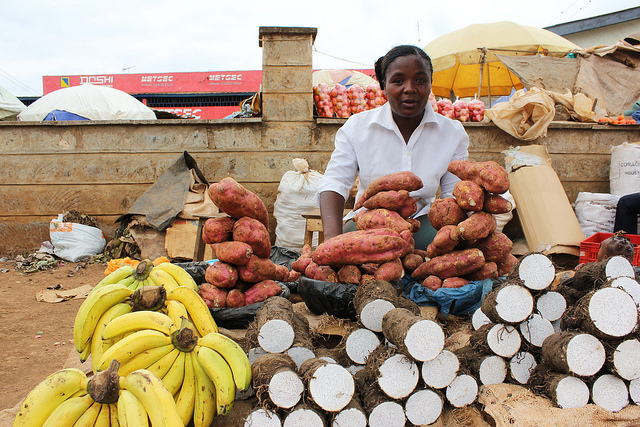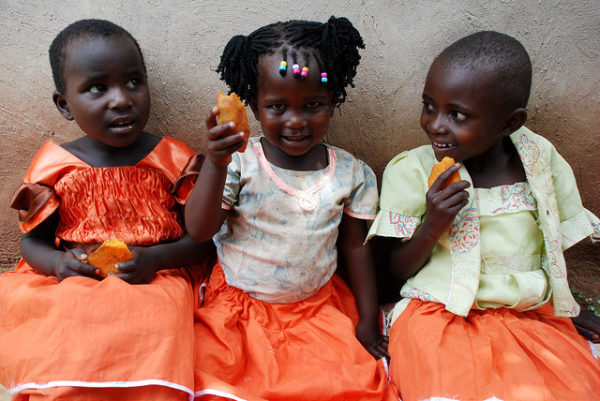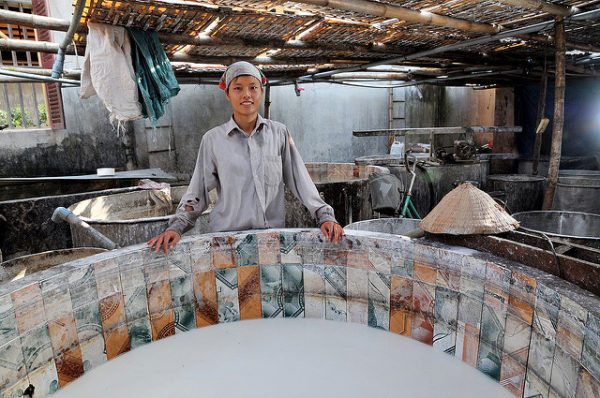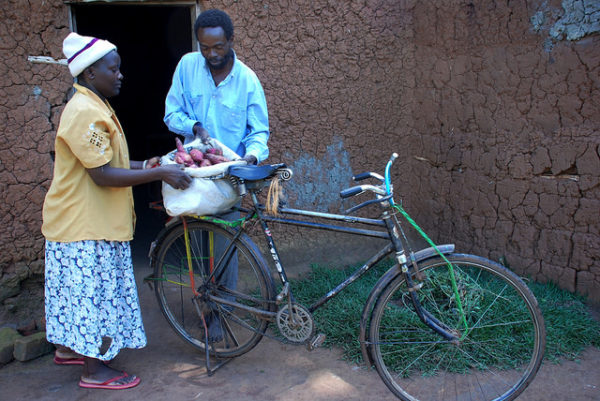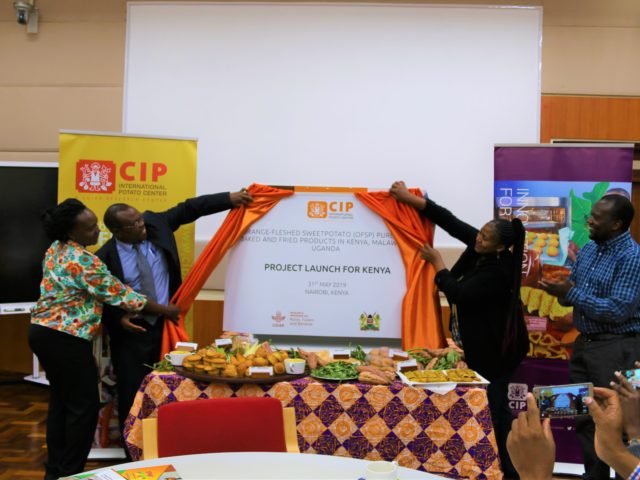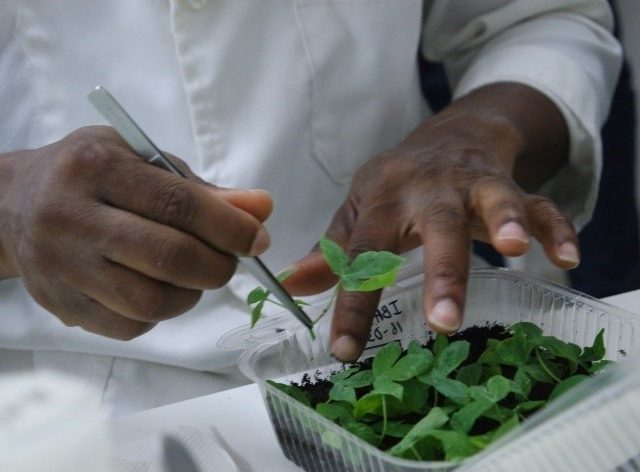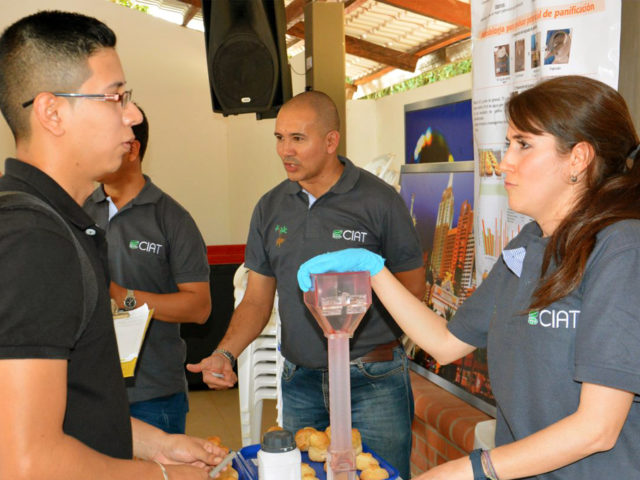“It starts with the person who wants to eat affordable, safe, nutritious food,” says Simon Heck, the Mozambique-based sweetpotato project leader for the International Potato Center and the leader of RTB’s Flagship Project 4 on Nutritious Food and Added Value. “The urban consumer will [represent] the majority [of consumers] soon, and we must focus on how they” – along with the smallholders raising and selling the crops – “attain the benefits of roots, tubers and bananas.”
With that vision in mind, this flagship has an important focus on promoting utilization and uptake of biofortified crops – those bred for maximum nutrients – such as orange-fleshed sweetpotato (OFSP), cassava, potato and potentially banana and yam too.
Levels of beta carotene in both OFSP and cassava – which the body converts to Vitamin A – is an area of special interest considering its role in the health and development of young children. Lacking sufficient Vitamin A, tens of millions of children in developing countries suffer from stunted growth which limits mental development, as well as premature death and blindness.
While work to enhance OFSP is well underway in RTB, other biofortification efforts show a great deal of promise. Among them: boosting iron and zinc levels in Irish potato and breeding cassava that (like OFSP) contains higher levels of beta carotene. While “cassava doesn’t respond as quickly” as OFSP does, Heck notes, it’s just as critical a crop to smallholders in certain regions.
To that end, geography and economics figure into which crops warrant biofortification research within FP4. “You might say, well, OFSP is much richer in beta carotene than cassava – but cassava can grow in places where nothing else grows,” Heck notes. Indeed OFSP can contain more concentrated levels of beta carotene, “but it’s limited in terms of its distribution.” Potato may be able to modified to contain more zinc, but the higher costs of raising potato may limit the benefit that nutritional boost can have.
Approaches to promoting biofortification in one crop can be deployed in the service of another, Heck says. “You build on what has been achieved,” he says. “It’s one of the values of how RTB approaches this work: in our platform, we can exchange scientific methods to accelerate progress across [multiple] crops. We owe it to the farmers [growing crops] and to the children [consuming them] to make full use of what each of us knows.”
For all crops, the effectiveness of crop processing and storage methods will affect smallholders’ outcomes and consumers’ health, too. The best varieties and harvesting techniques mean little if half the crops are lost due to spoilage or pests, so FP4 is looking closely at best practices in these areas as well. Methods ranging from pureeing OFSP for distribution in vacuum packed bags, to processing zinc-rich potato into flour, to storing harvested crops underground or at ambient temperatures to better support their preservation may be suitable, depending on a region’s climate, topography, financial stability, electrical grid health and other factors, Heck says.
FP4 is also paying close attention to improving the efficiency and reducing the energy and environmental footprint of cassava processing. Great strides have been made to understand how the higher efficiency of large scale cassava processing plants in Asia could be replicated at a much smaller scale in Africa and Latin America, opening up an important space for south-south learning.
In its clusters, FP4 must also pay heed to gender roles that may have long dictated tasks around growing and selling crops.
“Two domains that are often separate in many countries come together [under the auspices of FP4],” Heck says. “Men’s domain roles tend to be perceived to be around agriculture, while those of women are perceived to be around caregiving and feeding. Now, a lot of our assumptions seem to imply that somehow a benefit generated in one sphere will translate into benefits in another sphere, but we know it is not that easy.” The question becomes: “How do we involve both men and women in both spheres?”
Remember: a lot of OFSP, for example, is actually grown by women, Heck notes. By the same token, “we want to involve men in childcare, nutrition, materials extension and activities.” While gender-based roles are certainly bound by tradition, “they are never written in stone.” Working with more organizations that already have credibility in checking these assumptions is key to breaking down gender-based barriers.
In addition to working with organizations that can help examine gender-based assumptions, FP4 will develop partnerships with local health clinics and government agencies services. These organizations are often ideally placed to enable consumers to understand the healthful benefits of RTB through programs such as:
- Teaching adults how to prepare these foods, processed or not
- Working with pregnant women and mothers to help them learn about the role Vitamin A and other micronutrients play in the health of the developing fetus, infant and child
- Measuring health outcomes within a given community over time
FP4 is largely about “overcoming barriers of acceptance of crops,” Heck concludes. “One good thing about the biofortification strategy is that the crops you are biofortifying are ones that already exist, that are accepted [in the region]. People already know how to cultivate them; they’re already part of people’s recommended diets. We can tap into the capacity that is already there” – and, partnering with Flagship 5 on ‘Improved livelihoods at scale’ and others, scale up efforts to amplify biofortification’s potential to boost crop nutrition, hardiness and stability in a changing, hungry world.
This is the second in a series of blogs showcasing the new Flagship Projects of the CGIAR Research Program on Roots, Tubers and Bananas. The next edition will examine Flagship 3 on ‘Resilient Crops‘. By Amy Rogers Nazarov
